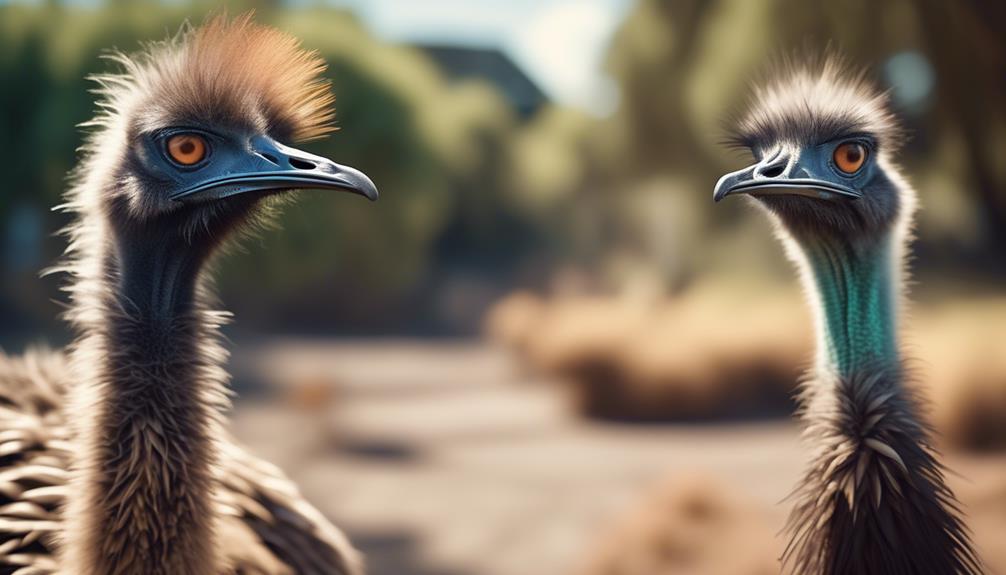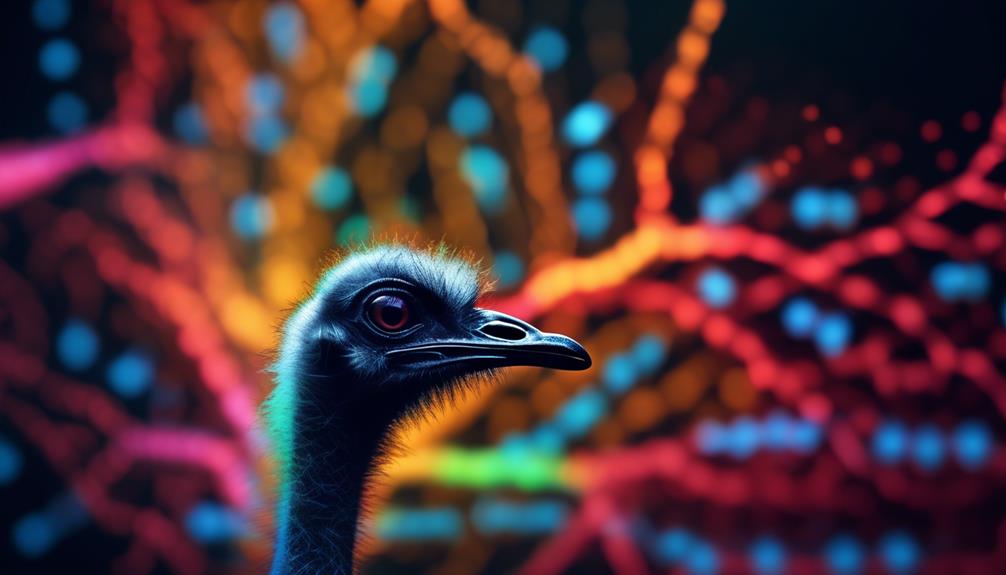
Have you ever wondered what makes emus so unique?
Well, let's travel back in time to explore the fascinating world of emu genetics.
From their physical traits to their behavior, emus are a treasure trove of genetic information waiting to be unraveled.
But why should you care?
Because understanding the hereditary traits of these majestic creatures not only sheds light on their evolutionary history but also helps us in conserving their species for future generations.
So, fasten your seatbelts as we embark on a journey through the mysterious realm of emu genetics, where we'll discover the secrets behind their distinctive features and the role genes play in shaping their lives.
Key Takeaways
- Emu coloration is determined by multiple genes, making it challenging to predict offspring coloration based on parents' appearance.
- Genetic markers can be used to identify individual emus and trace lineage, aiding in understanding emu domestication and selecting emus with desired traits.
- Emu behavior is influenced by both genetics and environmental interactions, and genetic markers help predict and understand emu behavioral traits.
- Genetic diversity in emus is important for their adaptation to changing environments, reducing the risk of inbreeding and negative consequences.
The Basics of Emu Genetics
Understanding the basics of emu genetics is crucial for comprehending the inheritance patterns and genetic traits that contribute to the unique characteristics of these fascinating flightless birds. One important aspect of emu genetics is the inheritance of coloration. Emus exhibit a range of color variations, including brown, black, and white feathers. The inheritance of color in emus is determined by multiple genes, with different combinations resulting in various color phenotypes. This complex genetic system makes it challenging to predict the coloration of offspring based solely on the appearance of the parents.
Additionally, genetic markers play a significant role in the domestication of emus. These markers are specific regions of DNA that can be used to identify individual emus and trace their lineage. By studying these genetic markers, researchers can gain insights into the history and domestication process of emus. These markers can also help breeders in selecting emus with desired traits, such as temperament, size, and disease resistance.
Emu Physical Traits and Inheritance
Emu physical traits and inheritance can be analyzed and understood by examining the genetic factors that contribute to the development and expression of these characteristics. Emu coloration inheritance is a fascinating aspect of their genetics. The color of an emu's feathers is determined by a combination of genetic factors, including the presence of specific pigments and the way these pigments interact with light. For example, the black coloration in emus is a result of the presence of eumelanin, a dark pigment. The expression of this pigment is influenced by the interaction between multiple genes.
Another physical trait that is influenced by genetics is emu size. Genetic factors play a significant role in determining the overall size of an emu. Researchers have identified specific genes that are responsible for regulating growth and development in these birds. These genes control factors such as bone growth, muscle development, and overall body size. By studying the inheritance patterns of these genes, scientists can gain insights into how emus grow and develop over generations.
To further emphasize the inheritance of emu coloration and the genetic factors in emu size, we can use the following table:
| Trait | Inheritance |
|---|---|
| Emu Coloration | Determined by multiple genes |
| Emu Size | Regulated by specific genes |
Understanding Emu Behavior Through Genetics

By examining the genetic factors that contribute to emu behavior, valuable insights can be gained into their behavioral patterns and tendencies. Genetic markers for emu behavior and genomic analysis have proven to be effective tools in understanding the complex nature of emu behavior. Here are three key points to consider:
- Inherited Traits:
Through genomic analysis, researchers have identified specific genetic markers that are associated with certain behavioral traits in emus. These markers can be used to predict and understand various aspects of emu behavior, such as aggression, mating patterns, and social dynamics.
- Environmental Interactions:
While genetics play a significant role in shaping emu behavior, it's important to note that their interactions with the environment also influence their behavior. Genomic analysis helps in identifying the genetic factors that make emus more adaptable and resilient to different environmental conditions, such as drought or changes in habitat.
- Conservation Efforts:
Understanding emu behavior through genetics is crucial for conservation efforts. By studying the genetic markers for behaviors like migration or foraging patterns, scientists can develop strategies to protect and preserve emu populations. This knowledge can also aid in managing captive emus and ensuring their well-being.
Genetic Variations and Diversity in Emus
Genetic variations and diversity in emus contribute to the intricate web of traits and characteristics that shape their behavior and adaptability. These genetic mutations and variations are an essential component of evolutionary genetics, allowing emus to adapt to changes in their environment and ensure the survival of their species.
One of the key factors contributing to genetic variation in emus is the presence of genetic mutations. These mutations can occur spontaneously or be inherited from their parents. They can result in changes in physical traits, such as feather coloration or body size, as well as behavioral traits, such as mating preferences or foraging strategies.
Evolutionary genetics plays a crucial role in shaping the genetic diversity in emus. It allows for the selection and propagation of advantageous traits that increase the emus' chances of survival and reproduction. This process occurs through natural selection, where individuals with beneficial genetic variations are more likely to survive and pass on their genes to the next generation.
The genetic diversity in emus is vital for their long-term survival and resilience. It provides them with the flexibility to adapt to changing environments, such as different climates or food availability. Additionally, genetic diversity reduces the risk of inbreeding and the associated negative consequences, such as reduced fertility or increased susceptibility to diseases.
The Role of Genes in Emu Health and Disease

The genetic makeup of emus plays a significant role in their overall health and susceptibility to diseases. Understanding the role of genes in emu health is crucial for maintaining their well-being. Here are three key points to consider:
- Genes and immune system: Emus possess a complex immune system that's regulated by specific genes. These genes play a crucial role in determining the efficiency of their immune response. Variations in these genes can impact the emus' ability to fight off infections and diseases. Genetic factors can influence the emus' susceptibility to specific pathogens and their ability to mount an effective immune response.
- Genetic disorders in emus: Just like any other species, emus can also experience genetic disorders. These disorders are caused by mutations or alterations in their genes, which can lead to various health problems. Some genetic disorders may affect the emus' growth, reproduction, or overall well-being. Identifying and understanding these genetic disorders can help in developing strategies to prevent or manage them effectively.
- Genetic testing and breeding programs: Genetic testing can provide valuable insights into the health and genetic makeup of emus. By identifying specific genes associated with diseases or genetic disorders, breeders can make informed decisions when selecting breeding pairs. This can help in reducing the occurrence of genetic disorders and improving overall emu health.
Genetic Factors Influencing Emu Reproduction
Emu reproduction is influenced by various genetic factors that contribute to their overall reproductive health and success. Genetic factors play a crucial role in determining the breeding success of emus, as they can impact the fertility and viability of offspring. Certain genetic mutations can have a significant impact on emu reproduction, affecting various aspects such as egg production, fertilization, and embryonic development.
Genetic factors can affect the reproductive health of emus in several ways. For instance, mutations in genes involved in hormone production or regulation can disrupt the hormonal balance necessary for successful reproduction. Additionally, genetic mutations can also affect the quality and quantity of gametes produced by emus, leading to reduced fertility or infertility.
The impact of genetic mutations on emu reproduction can be significant and can even lead to reproductive disorders. For example, mutations in genes responsible for eggshell formation can result in thin or weak eggshells that are prone to breakage, reducing the chances of successful incubation and hatching. Similarly, mutations affecting sperm production or function can impair fertilization, hindering the ability to produce viable offspring.
Understanding the genetic factors influencing emu reproduction is essential for effective breeding programs and conservation efforts. By identifying and managing genetic mutations that negatively impact reproductive success, breeders and conservationists can improve the overall reproductive health and success of emus, ensuring the long-term survival of this unique species.
Genetic Adaptations for Emus in the Australian Environment

Emus in the Australian environment have developed genetic adaptations that enable them to thrive in their unique surroundings. These adaptations have allowed emus to successfully navigate the challenges posed by the Australian landscape and climate. Here are three key genetic adaptations that contribute to their success:
- Enhanced thermoregulation: Emus possess genetic variations that enable them to regulate their body temperature effectively. This is crucial in the Australian environment, where temperatures can be extreme. Their genes allow them to dissipate heat efficiently and conserve water, enabling them to withstand the scorching heat.
- Efficient digestion: Emus have genetic adaptations that aid in their digestion of fibrous plant material, which is abundant in the Australian environment. Their unique digestive system allows them to extract nutrients from tough vegetation, providing them with the energy they need to thrive in their habitat.
- Agile locomotion: Emus have evolved genetic variations that enhance their agility and speed. This is essential for their survival in the vast and varied Australian landscape. Their strong legs, adapted for long-distance running, allow them to navigate diverse terrains, outrun predators, and find food and water sources.
These genetic adaptations highlight the remarkable genetic diversity present in emus. Through natural selection, emus have developed these traits over time, allowing them to adapt and flourish in the challenging Australian environment.
Conservation and Future Research in Emu Genetics
Having explored the genetic adaptations that enable emus to thrive in the Australian environment, it's now imperative to delve into the crucial topic of conservation and future research in emu genetics.
Conservation strategies play a vital role in preserving the genetic diversity of emus and ensuring their long-term survival. By safeguarding the genetic makeup of wild emu populations, we can maintain their adaptive potential and resilience to environmental changes.
One key approach to conservation is the identification and utilization of genetic markers. These markers are specific regions of DNA that can be used to distinguish between individuals and populations, providing valuable insights into genetic variation and relatedness. By studying these markers, researchers can assess the genetic health and diversity of emu populations, identify unique genetic lineages that may be at risk, and develop targeted conservation plans to protect them.
Future research in emu genetics should focus on expanding our understanding of the genetic basis of important traits, such as disease resistance and reproductive success. By uncovering the underlying genetic mechanisms, we can develop more effective conservation strategies and management practices.
Additionally, advancements in DNA sequencing technologies offer exciting opportunities to explore the entire emu genome, providing a comprehensive view of their genetic makeup and enabling us to better understand their evolutionary history and genetic adaptation.
Frequently Asked Questions
How Do Emus Use Their Genetics to Communicate With Each Other?
Emus use their genetics to communicate with each other through their vocalizations. The genetic basis of vocalization and the role of genetic variation in social behavior play a crucial role in their ability to convey messages and establish social connections.
Can Emus Inherit Personality Traits From Their Parents?
You know how some traits are passed down from your parents, like your curly hair or your love for music? Well, emus can also inherit personality traits from their parents through genetic predisposition and inherited behaviors.
Are There Any Genetic Factors That Influence the Color of an Emu's Feathers?
Genetic factors play a crucial role in determining the color of an emu's feathers. The genetic basis for feather coloration is complex, involving various genes that interact to create the beautiful array of colors seen in emus.
Do Emus Have Any Genetic Adaptations That Help Them Survive in Extreme Weather Conditions?
You bet! Emus have some incredible genetic adaptations that help them brave extreme weather conditions. Their genes give them the tools to withstand scorching heat, bone-chilling cold, and everything in between. It's nature's ultimate survival kit!
Is There a Genetic Link Between Emu Behavior and Their Diet Preferences?
The genetic basis of emu behavior and the genetic factors influencing their diet preferences are interconnected. Understanding the link between genetics and behavior can provide insight into why emus have specific diet preferences.
Conclusion
You have delved into the fascinating world of emu genetics, unraveling the mysteries behind their physical traits, behavior, and adaptations.
Through the study of genes, we've gained a deeper understanding of emus and their role in the Australian environment.
As we continue to explore genetic variations and their impact on emu health, reproduction, and diversity, we pave the way for conservation efforts and future research.
Emus are truly remarkable creatures, and their genetics hold the key to unlocking their secrets.




